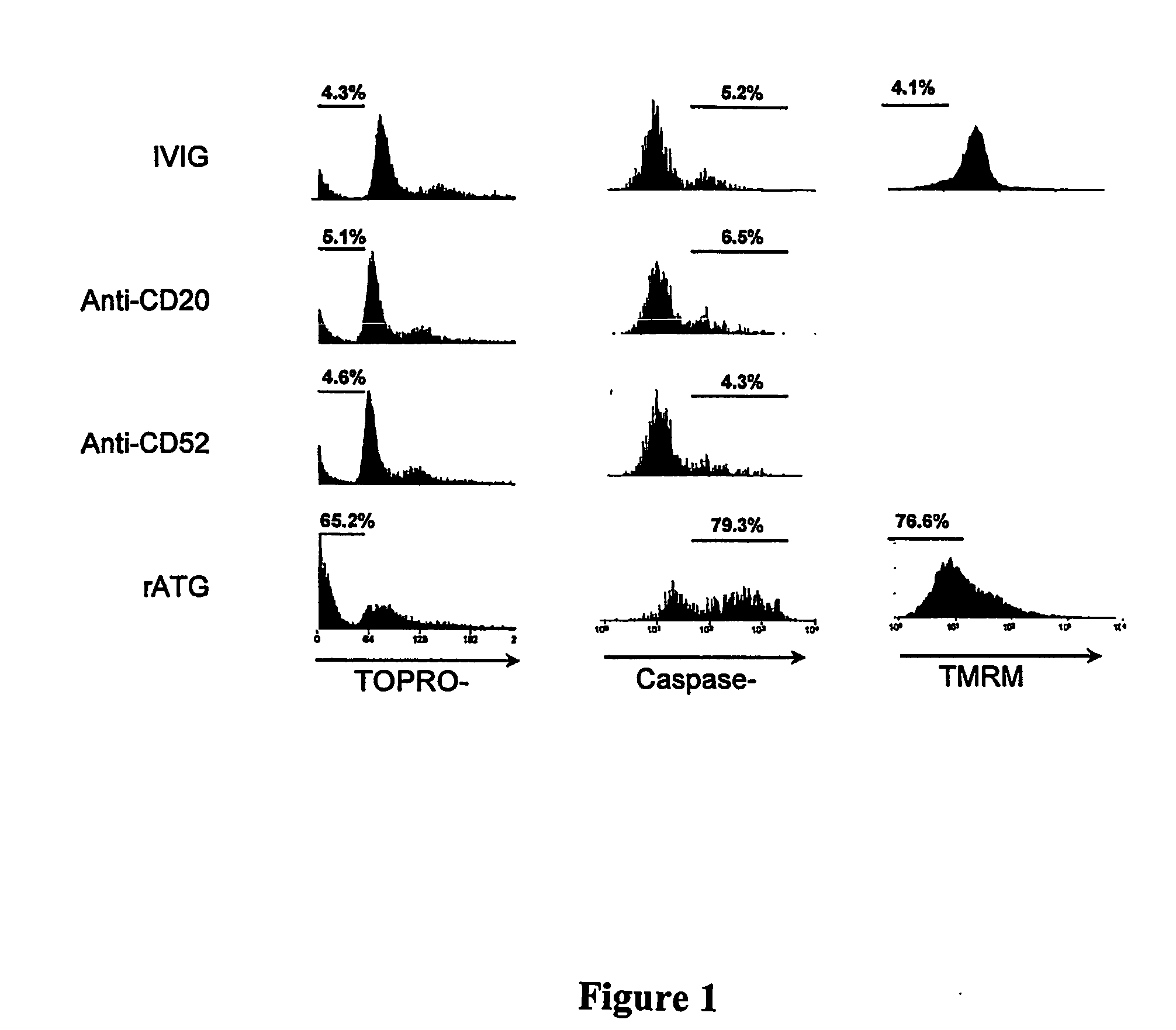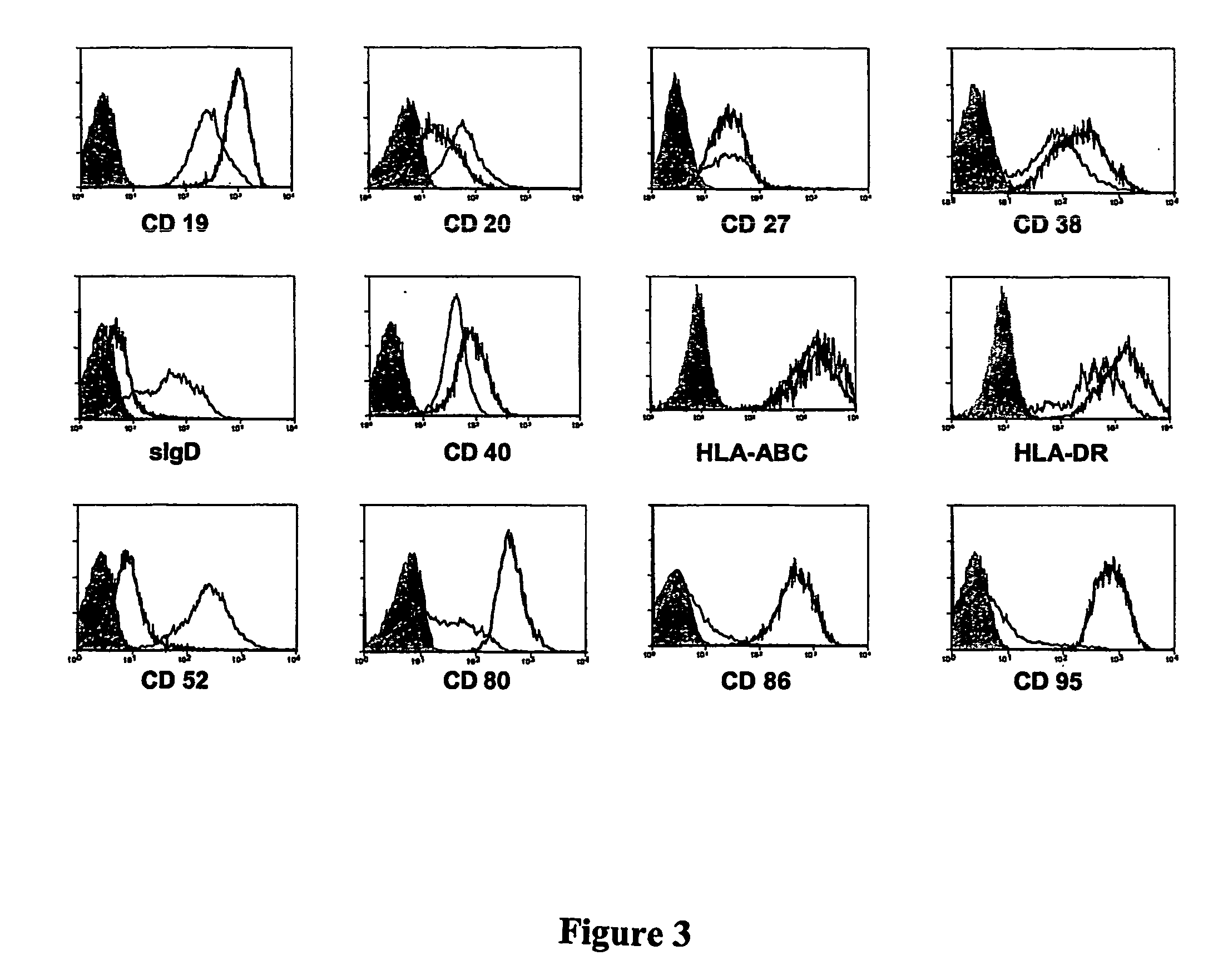Anti-thymocyte antiserum and use thereof to trigger b cell apoptosis
a technology of thymocyte antiserum and b cell apoptosis, which is applied in the field of preparation and use of antithymocyte antiserum to induce b cell apoptosis, and can solve the problem of ratg interfering with the t cell dependent activation of alloreactive cells
- Summary
- Abstract
- Description
- Claims
- Application Information
AI Technical Summary
Benefits of technology
Problems solved by technology
Method used
Image
Examples
example 1
Induction of B cell apoptosis by rATG
[0064] The ability of rATG to induce apoptosis in B cells was determined using four different assays (FIG. 1): loss of plasma membrane polarization by annexin V binding to the outer leaflet, subdiploid DNA content, caspase 3 induction, and loss of mitochondrial membrane potential measured by uptake of the dye TMRM. Incubation of rATG with CD40L activated B cells at increasing concentrations demonstrated a progression from live (Annexinneg, TOPROneg), to apoptotic (Annexinpos, TOPROneg), and finally late apopototic (Annexinpos, TOPROpos) phases. Several clinical protocols have been described for treatment or prevention of antibody mediated allograft rejection using IVIG, rATG, rituxumab, and alemtizumab. This panel of assays was therefore used to compare the induction of apoptosis for each of these agents at clinically relevant concentrations. rATG was the only agent to induce significant apoptotic change in all four assays.
example 2
Dose-Response Curves for Human Naïve and Activated B Cells, and Plasma Cells
[0065] Because B cells at varying stages of activation both express different surface markers (FIG. 2) and have varying sensitivity to antibody-mediated apoptosis, the ability of rATG to induce apoptosis in human naive B cells (CD20high CD27−), activated B cells (CD20lo, CD27hi) and normal bone marrow resident plasma cells (CD20−, CD138+) was tested. Cells were tested at clinically relevant range of rATG concentrations (1-1,000 μg / ml). All three cell types underwent dose-dependent induction of apoptosis with rATG (FIG. 2A). Given the differences in target antigen and Fc receptor expression between B cells of the naïve, activated and plasma cell phenotypes (See FIG. 3), an assessment was made as to the sensitivity of each of these subtypes to induction of apoptosis by other agents reported to have efficacy in treating antibody mediated allograft rejection or inducing B cell apoptosis. The sensitivity of each...
example 3
rATG F(ab)2 Fragment Activity Against B Cells is Augmented by FcR Ligation
[0066] Binding of antigen-antibody complexes to B cell Fcγ receptors is known, under some circumstances, to induce B cell apoptosis. For example, FcRγ ligation augments monoclonal anti-CD95 mediated apoptosis (Xu et al. “Fc Gamma Rs Modulate Cytotoxicity of anti-Fas Antibodies: Implications for Agonistic Antibody-Based Therapeutics,”J. Immunol. 171(2):562-568 (2003), which is hereby incorporated by reference in its entirety) and causes accelerated apoptosis of B cells (Ashman et al., “Fc Receptor Off-Signal in the B Cell Involves Apoptosis,”J. Immunol. 157(1):5-11 (1996), each of which is hereby incorporated by reference in its entirety). It was therefore examined whether FcR binding augmented the degree of ATG induced apoptosis. Incubation of CD40L activated B cells with rATG F(ab)2 fragments resulted in lower levels of apoptosis compared to the intact molecule (FIG. 4). While Fc ligation itself had little e...
PUM
 Login to View More
Login to View More Abstract
Description
Claims
Application Information
 Login to View More
Login to View More - R&D Engineer
- R&D Manager
- IP Professional
- Industry Leading Data Capabilities
- Powerful AI technology
- Patent DNA Extraction
Browse by: Latest US Patents, China's latest patents, Technical Efficacy Thesaurus, Application Domain, Technology Topic, Popular Technical Reports.
© 2024 PatSnap. All rights reserved.Legal|Privacy policy|Modern Slavery Act Transparency Statement|Sitemap|About US| Contact US: help@patsnap.com










